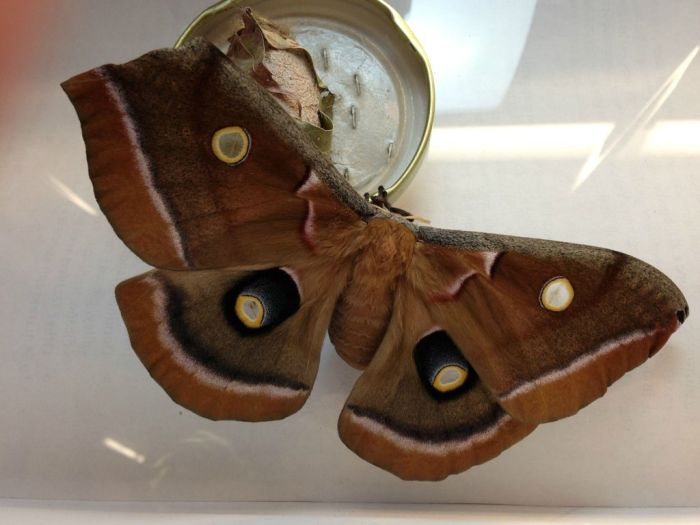|
|
Transformation Of Antheraea Polyphemus Moth
|
There are generally two broods throughout the United States, one that hatches in early spring and one that hatches in late summer. The moths eclose and then must pump their wings with fluid (hemolymph) to extend them. The females emit pheromones, which the male can detect through its large, plumose antennae. Males can fly for miles in order to reach a female. After the moths mate, the female spends the majority of the remainder of her life laying eggs, while the male may mate several more times. Adults of this family of moths have vestigial mouths, meaning their mouth parts have been reduced. Because of this, they do not eat and only live as adults for less than one week. In captivity, this moth is much more difficult to breed than other American Saturnids such as the cecropia, promethea or luna. Kept in a cage, the male and female tend to ignore each other, unless a food plant (particularly oak leaves) is present.
Sexual dimorphism
Differentiating between sexes of this species is very easy. The most obvious difference is the plumose antennae. Males will have very bushy antennae while females will have moderately less bushy antennae. The male's bushy antennae are used to detect pheromones released by unmated females. Another difference is that the females will be slightly larger in the abdomen due to carrying eggs. There is a surprising amount of variation within this species. Color patterns can range from a reddish-cinnamon to a dark brown but are almost always a shade of brown. In the late 1950s, amateur lepidopterist Gary Botting hybridized the Polyphemus moth (then known as Telea polyphemus) with Antheraea yamamai from Japan and, later, Antheraea mylitta from India by transferring the pheromone-producing scent sacs from female polyphemus to the Antheraea females and allowing polyphemus males to mate with them. The resultant hybrids were displayed in his winning U.S. National Science Fair exhibit "Intergeneric hybridization among giant silk moths." After Botting consulted with genetic statistician J.B.S. Haldane and his wife, entomologist Helen Spurway, the polyphemus moth was reclassified, becoming Antheraea polyphemus.
|
|









